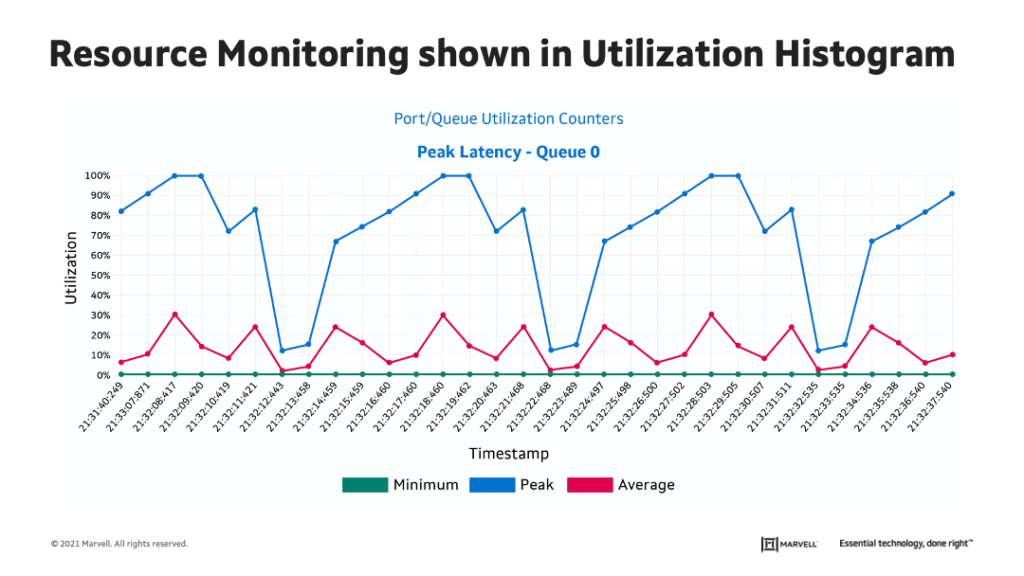- PRODUCTS
- COMPANY
- SUPPORT
- PRODUCTS
- BY TYPE
- BY MARKET
- COMPANY
- SUPPORT
Network Visibility of 5G Radio Access Networks, Part 2
In part one of this blog, we discussed the ways the Radio Access Network (RAN) is dramatically changing with the introduction of 5G networks and the growing importance of network visibility for mobile network operators. In part two of this blog, we’ll delve into resource monitoring and Open RAN monitoring, and further explain how Marvell’s Prestera® switches equipped with TrackIQ visibility tools can ensure the smooth operation of the network for operators.
Resource monitoring
Monitoring latency is a critical way to identify problems in the network that result in latency increase. However, if measured latency is high, it is already too late, as the radio networks have already started to degrade. The fronthaul network, in particular, is sensitive to even a small increase in latency. Therefore, mobile operators need to ensure the fronthaul segment is below the point of congestion thus achieving extremely low latencies.
Visibility tools for Radio Access Networks need to measure the utilization of ports, making sure links never get congested. More precisely, they need to make sure the rate of the high priority queues carrying the latency sensitive traffic (such as eCPRI user plane data) is well below the allocated resources for such a traffic class.
A common mistake is measuring rates on long intervals. Imagine a traffic scenario over a 100GbE link, as shown in Figure 1, with quiet intervals and busy intervals. Checking the rate over long intervals of seconds will only reveal the average port utilization of 25%, giving the false impression that the network has high margins, without noticing the peak rate. The peak rate, which is close to 100%, can easily lead to egress queue congestion, resulting in buffer buildup and higher latencies.
Figure 1: Port Utilization Traffic Scenario
Understanding port utilization is key for network planning and upgrade decisions from, for example, a RAN based on 10GbE links to a radio network based on 25GbE or 100GbE fiber links. Marvell’s resource monitoring tool continuously monitors the rates of all queues in the system, and provides the percentage of time, inside a second, that the port was between different port-utilization bins. In addition, the tool provides the minimum, average and peak queue rates in very short time intervals.
Figure 2 shows a graph of the minimum, average and peak rates (expressed as a percentage of the port’s speed) for a specific queue over time. While the samples are slow (every 1 sec), the underlying measurements are very fast measuring the correct values. Note that slow monitoring techniques would not have detected the correct peak rate and would have created the false impression that peak rate is much lower.
Figure 2: Monitoring Minimum, Average and Peak Resource Usage
In addition, the fast-changing rates inside each second are placed in rate histograms that reveal the percentage of time, inside each second, a queue was transmitting at a specific rate interval. Figure 3 shows such a histogram for a specific port. The vast amount of data points (continuous measurement of rates in the entire network) is dramatically reduced, allowing continuous monitoring of the entire network and providing extremely valuable information.
Figure 3: Resource Monitoring shown in Utilization Histogram
Open RAN Monitoring
Cloud RAN, vRAN and the proliferation of players in the Open RAN create new challenges for network visibility tools. Many functions are now deployed as virtual functions over virtual machines (VMs) or containers. The Digital Unit (DU) functions, which include complex baseband processing, can be implemented and accelerated using O-RAN compliant Network Interface Cards based on, for example, Marvell’s OCTEON Fusion®-O device. Virtualizing and running these real time functions on cloud servers is a challenging task that can consume most of the latency budget.
As shown in Figure 4, such Cloud RAN solutions are expected to be deployed in Edge Data Centers, in proximity to the cell towers.
Figure 4: Cloud RAN and vRAN
Like other data centers, Edge Data Centers are built in a Leaf-Spine CLOS architecture. Using Marvell’s Prestera Switches in the fronthaul Radio Access Network and in the Edge Data Center provide seamless visibility to the latency and the utilization of the network, including the utilization of the links towards the servers. It is critical to monitor and make sure that the load is being spread evenly between the servers and that no congestion is ever reached.
Summary
5G Radio Access Networks are now being widely deployed, making it essential to accommodate their low latency, high bandwidth connectivity that is enabling new industrial and enterprise use cases. Marvell’s Prestera switches equipped with TrackIQ visibility tools ensure the smooth operation of the network, allowing mobile operators to provide mission-critical, low-latency applications to their customers.
Recent Posts
- Custom Silicon: A Sea Change for Semiconductors
- Marvell Named to America’s Most Responsible Companies 2026 List
- 5 Times More Queries per Second: What CXL Compute Accelerators Can Do for AI
- Marvell Makes Inaugural 100 Best Companies in Southeast Asia List
- Marvell Earns “Fittest Firm” Title in Silicon Valley Turkey Trot for 10th Consecutive Year
Archives
Categories
- 5G (10)
- AI (46)
- Cloud (19)
- Coherent DSP (11)
- Company News (107)
- Custom Silicon Solutions (9)
- Data Center (69)
- Data Processing Units (21)
- Enterprise (24)
- ESG (10)
- Ethernet Adapters and Controllers (11)
- Ethernet PHYs (3)
- Ethernet Switching (41)
- Fibre Channel (10)
- Marvell Government Solutions (2)
- Networking (43)
- Optical Modules (19)
- Security (6)
- Server Connectivity (32)
- SSD Controllers (6)
- Storage (23)
- Storage Accelerators (4)
- What Makes Marvell (47)
Copyright © 2025 Marvell, All rights reserved.
- Terms of Use
- Privacy Policy
- Contact

